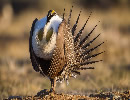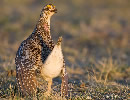Information About Grouses & Grouses Pictures
General info
Grouses are medium to large-sized "gamebirds". They have rounded bodies, short wings and small heads with stout, arched bills. Their main food is shoots, buds and seeds of small shrubs and herbs. All grouses spend most of their time on the ground, though when alarmed, they may take off in a flurry and go into a long glide. Red grouses are especially associated with heather; black grouses prefer a mixture of heather, rushy areas, rough grass and woodland edge, while capercaillies survive best where pine woodland intermingles with boggy heath and plentiful supplies of bilberry, cranberry and crowberry. Grouses can be found in the central and western part of the United States, the most popular species being the Greater Sage Grouse, which is on the point of becoming an endangered species.
Pictures
Habitat
Grouses usually consider a suitable habitat the one that is around drumming logs. The area must have sufficient stem density and canopy coverage to provide protection from hawks and owls. At least one drumming log per acre is required.
Diet
These birds feed mainly on vegetation buds, leaves, catkins, and twigs which typically accounts for over 95% of adults' food by weight. Thus, their diets vary greatly with the seasons. While hatchlings mostly eat insects, adults feed on vegetation. In order to digest vegetable food, grouse have big gizzard, and they eat grit to break up the food.
Reproduction
As far as reproduction is concerned, males are polygamous. The displays feature males' bright-colored combs and in some species, bright-colored inflatable sacs on the sides of their necks. The males display their plumage, give vocalizations that vary widely between species, and may engage in other activities, such as drumming or fluttering their wings, rattling their tails, and making display flights.
The nest is often in cover, with a scanty lining of plant material. The female lays one clutch, but may replace it if the eggs are lost. She begins to lay about a week after mating and lays one egg every day or two; the clutch comprises five to 12 eggs. On laying the second-last or last egg, the female starts 21 to 28 days of incubation. The female stays with them and protects them until their first autumn, when they reach their mature weights.
Predators
The nest is often in cover, with a scanty lining of plant material. The female lays one clutch, but may replace it if the eggs are lost. She begins to lay about a week after mating and lays one egg every day or two; the clutch comprises five to 12 eggs. On laying the second-last or last egg, the female starts 21 to 28 days of incubation. The female stays with them and protects them until their first autumn, when they reach their mature weights.
Grouses are mostly hunted by winged predators, which are very efficient at catching them. The goshawk may be the most frequent of all the grouses’ predators, but the horned owl kills more grouses annually than the others. Grouses are also hunted by people, who use them for food, sports and others. However, their natural predators (foxes, goshawks and owls) mainly target the young grouses.
Hunting Tips & Tricks
Grouse hunting can prove to be quite difficult for beginners, and that is why hunting with dogs is more than recommended. Another thing you should take into account is the equipment. From boots, to layers and rifles, all these aspects should be treated very seriously. If you want to find out more useful information on what to do when going grouse hunting, feel free to read our Grouse Hunting Tips section.
Interesting Facts
Did you know that the male Ruffed Grouse was called “carpenter bird� The sound made when they cupped their wings and rapidly beat them resembled the beating of its wings against a log. Also, the sound made by the grouses, called drumming, made various people believe that was the sound of starting engine. If you want to find out more interesting facts about each species, go to our Grouse Facts page.
Hunting Season
Despite the fact it is quite difficult to hunt grouses, due to their ability to quickly run away from the danger, there are many hunters willing to accept the challenge. The season lasts from August to December, although it may differ according to the regulations of each state.
Grouse Hunting Video
General Info
Equipment & Supplies



















